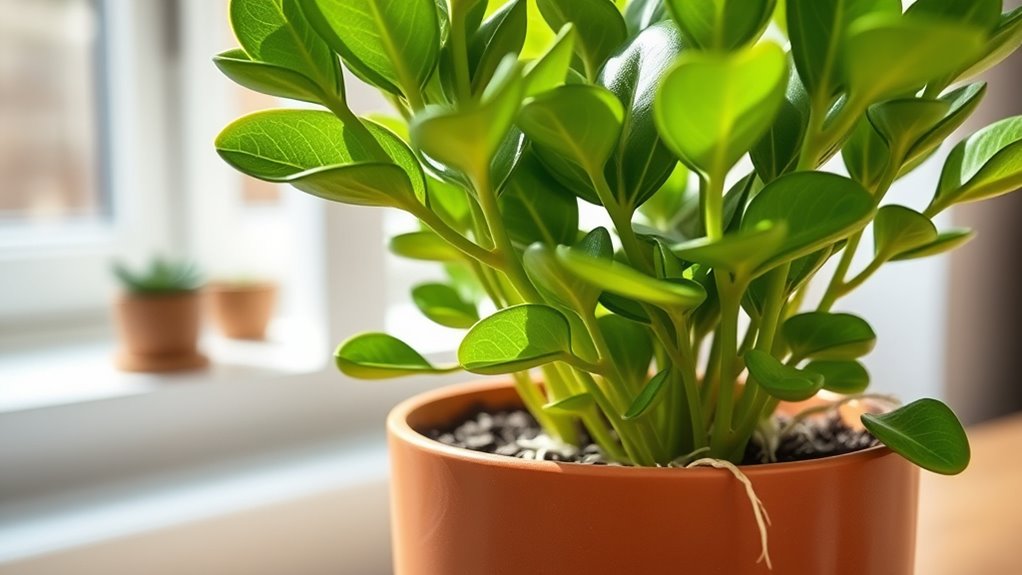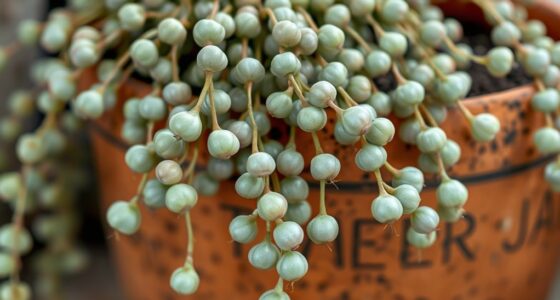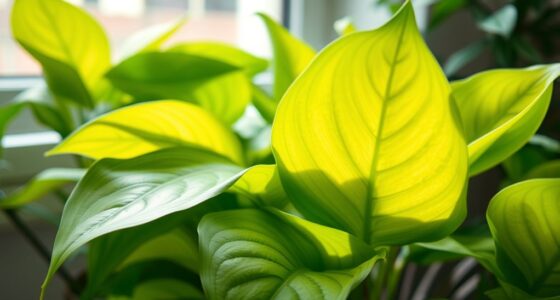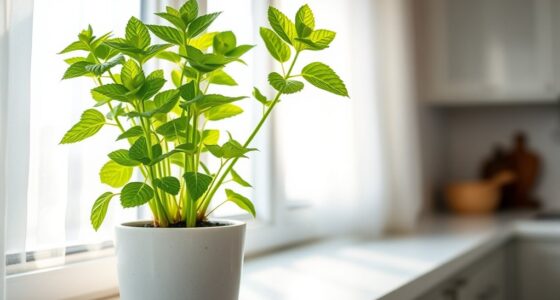To keep your jade plant healthy, place it in bright, indirect sunlight and rotate regularly. Use well-draining succulent soil and make certain the pot has drainage holes. Water only when the top inch or two of soil is dry, reducing watering in winter. Fertilize monthly during active growth and prune to promote bushiness. Keep an eye out for pests like mealybugs and spider mites, and learn more tips to maintain your lucky money tree’s robustness.
Key Takeaways
- Place your jade plant in bright, indirect sunlight for at least 6 hours daily, using grow lights if needed.
- Water only when the top 1-2 inches of soil are dry, reducing frequency in winter to prevent overwatering.
- Use well-draining succulent soil and pots with drainage holes to avoid water buildup and root rot.
- Fertilize every 4 weeks during active growing seasons with a potassium-rich succulent fertilizer; avoid feeding during dormancy.
- Regularly inspect for pests like mealybugs and spider mites, and prune to encourage bushier, healthy growth.
Optimal Lighting and Positioning
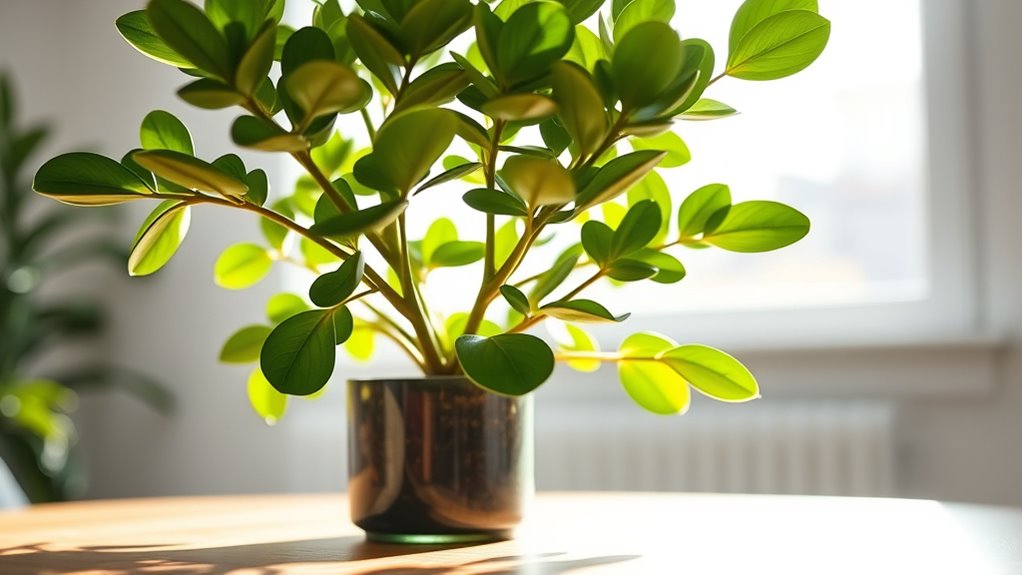
To keep your jade plant healthy and vibrant, it’s essential to give it the right amount of light. Place it in a south- or west-facing window to ensure it gets at least six hours of bright light daily.
Bright, indirect sunlight is ideal; direct harsh sunlight can burn the leaves, so avoid placing it in direct sun for extended periods. If natural sunlight is limited, supplement with grow lights to provide consistent light exposure.
Keep an eye on the leaf edges—if they develop a red tint, your plant is getting enough light.
Rotate the plant regularly to promote even growth and prevent leaning. Proper positioning and sufficient light exposure are key to maintaining the lush, healthy foliage of your jade plant.
Proper Soil and Pot Selection

Choosing the right soil and pot is essential for your jade plant’s health. Use a well-draining succulent mix with sand, perlite, or grit, and pick a pot with drainage holes to prevent water buildup. Make sure the pot size suits your plant to avoid over- or under-watering issues. Additionally, selecting the appropriate soil type can help maintain proper moisture levels and promote healthy root growth. Recognizing the importance of fatherhood and nurturing the bond with your plant can enhance its growth and resilience.
Choose Well-Draining Mix
Selecting a well-draining mix is essential for keeping your jade plant healthy and preventing root rot. Use a succulent or cactus-specific potting mix that contains sand, perlite, or pumice to assure excellent drainage. Incorporate well-draining materials like grit or gravel into your soil to improve moisture flow and aeration. When watering, avoid over-saturating the soil; the mix should dry out between watering sessions. Choose a pot with drainage holes to allow excess water to escape, reducing water accumulation at the bottom. Maintain the soil pH between 5.5 and 7, which is ideal for jade plants. Steer clear of heavy, dense soils that retain water and opt for loose, airy mixes designed specifically for succulents to promote healthy root systems. Proper watering practices and avoiding overwatering are crucial, as they directly impact the health of your plant’s roots and overall growth. Additionally, using necessary cookies can help ensure your experience with soil and watering management tools is smooth and secure.
Select Appropriate Pot Size
Ensuring your jade plant is in the right-sized pot is crucial for healthy growth. Choose a pot with drainage holes that’s only slightly larger than the root ball to prevent overwatering and promote proper soil conditions.
For small to medium-sized jade plants, opt for a 4- to 6-inch diameter pot. Larger plants need heavier, stable containers to support their size and weight.
Use unglazed terracotta or clay pots, which help moisture evaporate and reduce waterlogging risks. When repotting, select a well-draining soil or potting mix with added perlite or pumice to support healthy root development.
Regular repotting every 2-3 years with fresh soil keeps the soil conditions ideal. Proper pot size and soil choice are key to avoiding root rot and encouraging a thriving, healthy jade plant.
Additionally, choosing containers made from electric bike materials like lightweight plastics or composites can make handling and repotting easier.
Watering Techniques for Healthy Growth

To keep your jade plant healthy, you need to water it only when the top 1-2 inches of soil feel dry.
During spring and summer, a weekly watering usually suffices, but you’ll need to adjust based on humidity and temperature.
In winter, cut back to about once a month, ensuring the soil stays just slightly moist without pooling water.
Watering Frequency Guidelines
Water your jade plant deeply once a week during its active growth period, allowing the soil to dry out completely between waterings. Proper watering depends on your environment, so observe how quickly your soil dries. During dormancy in winter, reduce watering to about once a month to prevent overwatering. Always verify your pot has drainage holes to avoid waterlogging, which can harm roots. Use rainwater or low-calcium tap water to prevent mineral buildup. Adjust watering frequency based on light, temperature, and humidity. Additionally, employing watering techniques can help monitor soil moisture levels more precisely. Understanding how to manage soil moisture is essential for healthy growth. Here’s a quick guide:
| Season | Watering Frequency | Soil Conditions |
|---|---|---|
| Active growth | Once a week | Moist but well-drained |
| Dormancy | Once a month | Slightly drier |
| Environment | Adjust as needed | Avoid waterproof soil |
Regularly inspecting your plant’s roots can help identify overwatering signs, ensuring healthy growth. Incorporating knowledge about watering techniques and soil moisture levels ensures your jade plant remains vibrant and healthy.
Soil Dryness Indicators
Monitoring soil dryness is key to maintaining a healthy jade plant. When the soil feels dry at about an inch deep, it’s time to water.
During active growth, only water when the top 1-2 inches are completely dry, preventing overwatering. Use a moisture meter for accurate soil moisture readings, avoiding guesswork and reducing the risk of overwatering or underwatering.
Keep an eye on the leaves; shriveled or wrinkled leaves often signal the soil is too dry and needs watering. Proper soil moisture levels are also affected by soil drainage, which ensures excess water doesn’t accumulate and cause root rot.
Good air circulation around the plant can help prevent excess humidity and fungal issues, promoting healthier growth.
During winter dormancy, let the soil dry out completely between watering sessions to prevent root rot. Incorporating mindfulness practices when caring for your plant can help you tune into its needs and respond more effectively.
Proper moisture management ensures your jade plant stays healthy and vibrant.
- Check soil moisture by touch or with a moisture meter
- Watch for leaves that appear shriveled or wrinkled
- Allow soil to dry between watering, especially in winter
- Soil moisture detection technology can help you maintain optimal watering schedules.
Fertilizing and Feeding Strategies
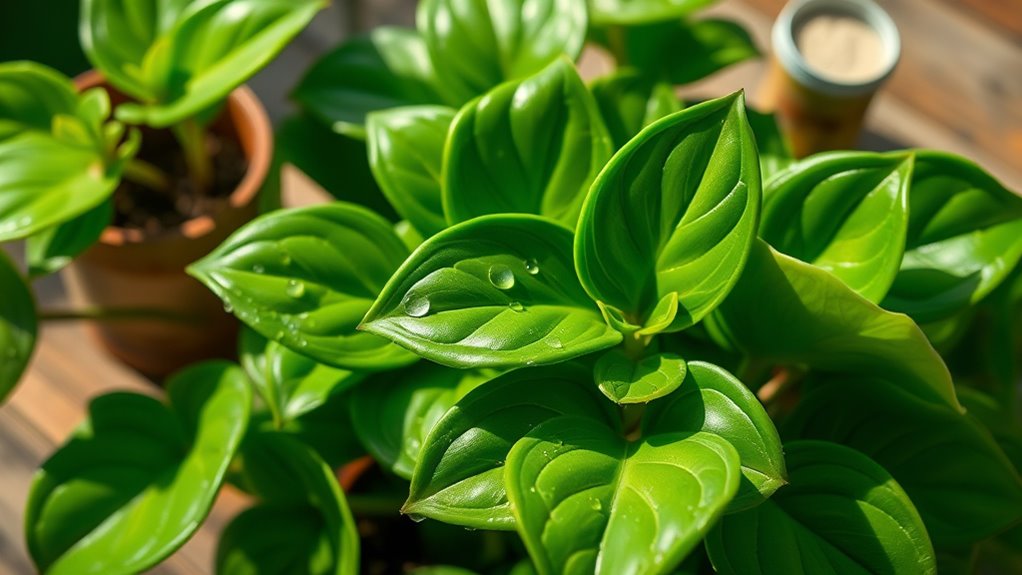
Fertilizing jade plants effectively involves timing your feeds to match their active growing periods in spring and summer. During this time, you should fertilize approximately every four weeks with a succulent-specific fertilizer high in potassium for proper plant nutrition. Use a balanced liquid fertilizer diluted to half strength or a slow-release granular option formulated for cacti and succulents. Avoid feeding during fall and winter dormancy, typically from November to February, when growth slows down. Long-term fertilization, like annual application of Plantura All Purpose Plant Food, can support overall health. Remember, overfeeding can cause root burns and leggy growth, so stick to recommended rates. Proper watering and feeding schedules optimize your jade plant’s essentiality.
| Fertilizer Type | Application Frequency |
|---|---|
| Succulent-specific fertilizer | Every 4 weeks in active season |
| Slow-release granular fertilizer | Once every 3-4 months |
| Balanced liquid fertilizer | Half strength during spring/summer |
| Long-term plant food | Annually |
| Avoid during dormancy | From November to February |
Pruning and Propagation Methods
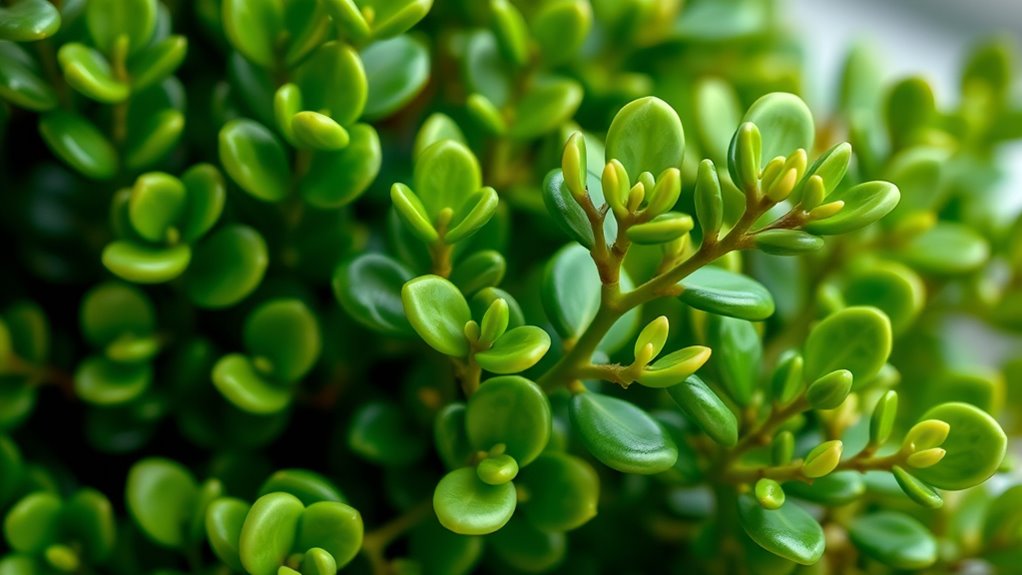
Pruning and propagation are essential for maintaining a healthy, attractive jade plant. Proper pruning encourages bushier growth, shapes the plant, and removes leggy or damaged stems. You should prune in spring or right after flowering, using clean, sharp scissors or pruning shears. Make cuts just above a leaf node or branch junction to promote healthy growth. Removing upward or downward shoots helps maintain a balanced, attractive plant shape. Additionally, understanding Halloween traditions can inspire festive touches in your plant displays or decorations during the season. To propagate, take stem cuttings and let them callus for a few days before planting in well-draining soil. This method allows you to create new jade plants easily and efficiently. Regular pruning and propagation keep your jade plant thriving, fuller, and more visually appealing. Engaging in proper plant care practices ensures your jade plant remains healthy and vibrant throughout the year. Incorporating unique plant propagation techniques can further enhance your gardening success and plant vitality. For optimal results, consider using quality soil mixes designed specifically for succulents and cacti to support healthy root development. Also, being aware of unique dog breed traits, such as those found in various breeds like Golden Retrievers or Poodles, can inspire you to choose the perfect pet to accompany your gardening hobby.
Identifying and Managing Common Pests

Identifying and managing common pests is essential for keeping your jade plant healthy and vibrant.
Mealybugs appear as white, cotton-like patches at leaf-stem junctions, and you can remove them with a cotton swab dipped in rubbing alcohol.
Spider mites are tiny pests that cause fine webbing and stippling on leaves; control them with insecticidal soap or neem oil.
Scale insects look like small, immobile bumps on stems and leaves and can be scraped off or treated with horticultural oil.
Regular inspection helps catch pests early, preventing severe infestation.
To effectively control pests, understanding Gold IRA fees and their impact on investments can help you make informed decisions for your plant care budget as well.
Encouraging natural predators like ladybugs can help keep pest populations in check without harming your jade plant.
Prompt action ensures your plant stays healthy and pest-free.
Frequently Asked Questions
How Do You Take Care of a Jade Money Tree?
To take care of your jade money tree, place it in a bright spot with at least six hours of indirect sunlight daily.
Water it deeply once a week when the topsoil feels dry, and reduce watering in winter.
Use well-draining soil and make certain the pot has drainage holes.
Prune in spring to shape it, and regularly check for pests, treating them promptly to keep your plant healthy.
How Do I Make My Jade Plant Happy?
To make your jade plant happy, give it plenty of bright, indirect sunlight—at least six hours daily.
Water only when the topsoil feels dry to prevent overwatering.
Use well-draining soil and a pot with drainage holes.
Regularly prune to shape and remove dead stems.
Keep indoor temperatures steady between 65°F-75°F, avoid drafts, and maintain a consistent environment.
These steps guarantee your jade stays healthy, vibrant, and happy.
Do Coffee Grounds Help Jade Plants?
Think of coffee grounds as a vintage record—useful if handled carefully. They can slightly acidify the soil and add nitrogen, which benefits jade plants when used sparingly. However, too much can cause excess moisture and root rot.
Always dry or compost the grounds first, then mix them well into a well-draining soil. For best results, rely on specialized succulent fertilizers, and use coffee grounds as a small supplement, not a primary source.
How Do You Perk up a Jade Plant?
To perk up your jade plant, start by giving it at least six hours of bright, indirect sunlight daily.
Water only when the top inch of soil is dry, and avoid overwatering in winter.
Remove dead or leggy stems to encourage bushier growth, and prune overgrown branches.
Check for pests like mealybugs and treat them promptly.
Repot every 2-3 years to refresh nutrients and support healthy growth.
Conclusion
By following these gentle tips, you’ll nurture your jade plant into a thriving symbol of prosperity. With just a bit of attention and love, you’ll create a welcoming environment where your money tree can flourish. Remember, patience and care are your best allies—soon, your plant will reward you with its lush, vibrant presence. Keep nurturing it with kindness, and enjoy the peaceful growth that comes from your thoughtful efforts.
